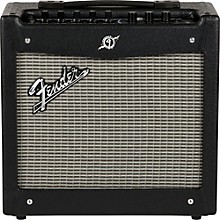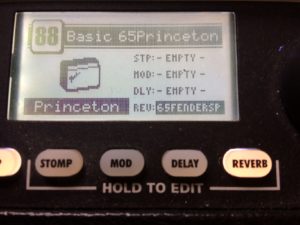
Taking the Fender Mustang Amps Into the Great Beyond–At Least Part Way
Now that I’ve completed my blues and rock patchset for the Fender Mustang series amps, I’ve started work on a more effected-up set of patches for players who want to take their music deeper into Rock-ville.

What I’m learning is that the FX in the Mustang are variable in their quality and effectiveness for harmonica. I’m really liking the delays, which are full of character and nicely varied. The tape delay, multitap, and ducking delays all sound great and do a lot to turn a basic tone into something much more special. The reverbs sound good, although the mix control seems to act logarithmically rather than linearly–in other words, a tiny little increase in the reverb mix puts a LOT of reverb in the mix. The modulation FX–chorus, flange, phaser, and pitch shift, including harmonized pitch shifter–all sound very good, and I REALLY like the inclusion of a pre-delay on the pitch shifter–delaying the entrance of a pitch-shifted tone by a few milliseconds does a lot to make it sound like two different players are playing, which is great for horn-section effects.
But There. Are. Limits. The signal path you can access from the front panel is fixed (though you can load FX in any order in the FUSE application, so long as you only use one of each type), and you can’t do things like insert a compressor and a distortion into the path at the same time. As with the Digitechs, you only get one modulation effect per patch. One cool thing is that the auto-wah effect (called “touch wah” on the Mustangs) is considered a “stomp” effect by the Mustangs, so you can use it alongside a modulation effect–in particular, a pitch shifter. An auto-wah into a pitch shifter set to an octave down (or vice versa) is a spectacular sound for harmonica, and this auto-wah works well with the low-pass set to maximum and the range set to taste.

The limits on the Mustang’s FX setup aren’t really that disappointing when you consider that this amp is more of an amp than an FX box. The amp models in the Mustangs are really good, the delays are excellent, and the reverbs work fine if you keep them on a leash. In other words, for players who want plenty of blues power in an amp, this thing delivers. The relative scarcity of harp-friendly FX compared to a Digitech RP or Zoom G3 isn’t a problem for those players, especially since the ones that are present and sounding good include the rotating speaker and pitch shift FX, by far the friendliest choices for a blues player. And for anyone else, it’s worth noting that the Mustang has an FX loop built-in that you can use to put anything else you like into the signal path. Maybe I’ll try the RP500 or the Zoom in the FX loop sometime soon…
Tags In
Related Posts
2 Comments
Leave a Reply
You must be logged in to post a comment.
WHAT’S NEW
Categories
- Audio/Video
- Blog
- Blue Future
- Digitech RP Tricks and Tips
- Discography, CDs, Projects, Info, Notes
- Featured Video
- For the Beginner
- Gallery
- Hunter's Effects
- Hunter's Music
- Huntersounds for Fender Mustang
- Meet the Pros
- More Video
- MPH: Maw/Preston/Hunter
- My Three Big Contributions
- Player's Resources
- Pro Tips & Techniques
- Recommended Artists & Recordings
- Recommended Gear
- Recorded Performances
- Reviews, Interviews, Testimonials
- The Lucky One
- Uncategorized
- Upcoming Performances
- Zoom G3 Tips and Tricks

I boght your pathes . Now what?
@Clarke: check your email for another copy of the patch set plus instructions. Contact me directly via email if you need further assistance. Thanks, RH